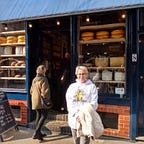London’s burning — Part 2
I am sure you will recall that I told you to remember the first church to be destroyed by the Great fire of London was St Margaret New Fish Street in part 1 of this story, well today I am going to tell you about what sits, or rather stands, on the site today.
The plaque in the photo above is the only reminder to church situated on the site lost to the Great Fire in 1666. A total of 87 churches were destroyed in the fire and only 51 were rebuilt. St Margaret’s wasn’t one of the 51 and it’s parish was merged with that of St Magnus the Martyr located less than 100m down the hill by the original entrance to London Bridge. St Magnus’s was also destroyed in fire and rebuilt to designs of Christopher Wren.
I will tell you about St Magnus’s church another time but I will show you the stained glass window inside dedicated to St Margaret’s church.
So onto today’s tale, I expect the eagle eyed will have already spotted it in background the photo of St Magnus’s church, yes the tall column with a golden top which is known simply as The Monument. Let’s take a closer look.
After the fire King Charles said the City of London should be rebuilt and redesigned to prevent another fire and that there should be regulations in place. The rebuilding act of 1667 prescribed how the new buildings should be built. It also stated that “And the better to preserve the memory of this dreadful visitation, be it further enacted That a column or pillar of brass or stone be erected on or as near unto the place where the said fire so unhappily began as conveniently may be, in perpetual remembrance thereof…” In 1677 The Monument opened.
With St Margaret’s church not being rebuilt it left a convenient space “as near unto the place where the said fire so unhappily began” for the column to be erected. 202ft (62m) away to be precise. Why is 202ft such a significant number? Because the monument is 202ft high so if it was to be laid horizontally it’s tip would touch the spot in Thomas Farriner’s bakery where the fire started.
When it was erected the granite column with golden flame on top would have been quite an arresting sight and much taller than the buildings surrounding it.
Today however The Monument is dwarfed by the surrounding office buildings like the one I wrote about when we visited the Sky Garden.
The monument was designed by Robert Hooke and Christopher Wren. The base has a sculpture by Caius Gabriel Cibber which represents the King affording protection to the desolate city and freedom to it’s rebuilders and inhabitants.
The remaining panels have Latin inscriptions, the north records the destruction of the city, the south the rebuilding of the city and the east the years and mayoralties in which erection of the monument took place.
At the top of the monument sits a golden urn of flames.
Several designs for the top were considered by Wren including a phoenix and a statue of King Charles II but the gleaming gold looks magnificent even on a dull day.
I know what you are thinking dear reader, is that a doorway at the base? Can you go inside? Can you climb to the top? Well the answer is Yes to all three questions…
I have written before how neither Lee nor I like heights and Lee absolutely hates spiral staircases well…
Start counting… 1, 2, 3, 4, 5, 6, 7, 8… Lee is looking unhappy already…
311 steps later we step outside with legs like jelly, clinging to the handrail Lee looks mightily relieved. The view from the top is obstructed by the the surrounding buildings but it is still impressive.
The viewing platform was originally just had a fence surrounding it but following several accidents where people fell to their death and six suicides a cage was added to the platform.
The mesh of the cage does get in the way of the view and there are higher vantage points but the views are still breathtaking…
Or maybe it was climbing all those stairs that took my breath away…
Talking of which we need to get Lee back down the stairs to the ground, and he hates going down spiral staircases even more than going up! Wish us luck! If we survive, I will tell you a bit more about the how the Great Fire of London is remembered soon…
Спасибо за прочтение. Продолжение следует…
Thanks for reading. To be continued…
If you enjoyed reading please like and follow me, I would also be grateful if you would consider buying me a coffee at ko-fi.
My blog is also available in Russian here if you have time please visit and like, it is greatly appreciated.
